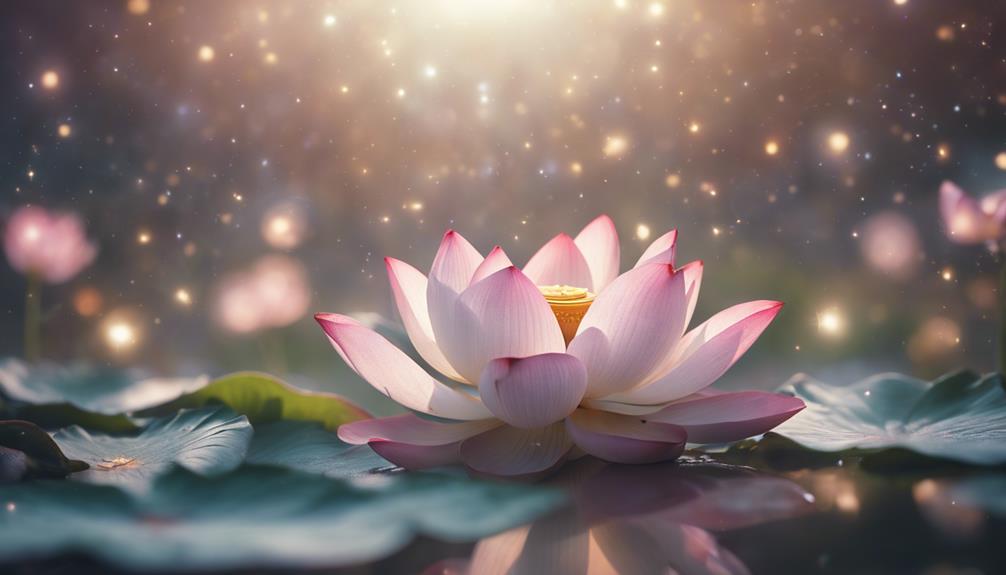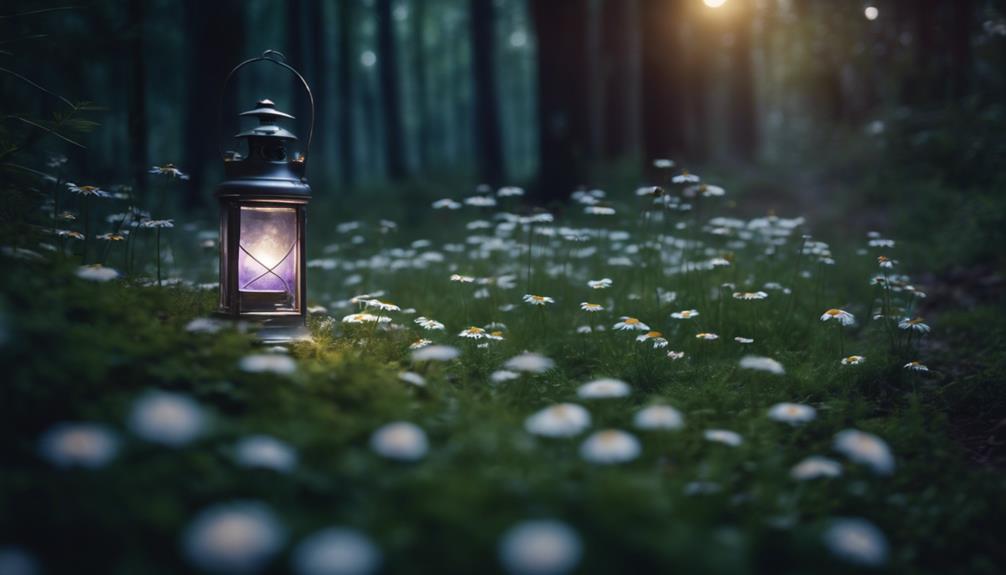As we explore the domain of astro herbalism, we discover a holistic practice that integrates celestial bodies, plants, and human well-being to promote personalized wellness and healing. This ancient practice, rooted in Babylon, correlates plants with planets, zodiac signs, and elements to enhance holistic healing and wellness practices. By understanding the principles of plant classification, elemental correspondences, and the role of doshas and planets, we can reveal the full potential of astro herbalism. As we venture further into this fascinating territory, we'll uncover the many benefits of integrating astrology with herbalism, and unveil the secrets to a more balanced and holistic approach to wellness.
Key Takeaways
• Astro Herbalism combines celestial bodies, plants, and human well-being to promote holistic healing and personalized wellness practices.
• Plant classification in Astro Herbalism is based on astrological principles, linking plants to planets, zodiac signs, and elements.
• Elemental correspondences and zodiac sign alignments influence the selection of herbs for specific purposes, enhancing holistic healing practices.
• Doshas and planetary influences guide the selection of balancing herbs, offering an inclusive wellness approach by integrating astrology with herbalism.
• Integrating astrology with herbalism provides insights into individual wellness journeys, amplifying therapeutic effects and fostering emotional resilience.
What Is Astro Herbalism?
As we explore the world of Astro Herbalism, we uncover a holistic practice that weaves together the mystical connections between celestial bodies, plants, and human well-being.
At its core, Astro Herbalism is an ancient practice that correlates plants, planets, zodiac signs, and elements to promote holistic healing and self-care rituals. This unique approach recognizes the profound influence of the starry sky on both human bodies and plants, acknowledging that the celestial domain has a profound impact on our well-being.
By understanding the astrological correspondences between herbs and zodiac signs, we can create personalized wellness practices tailored to our individual needs. This integration of astrology, plants, and planets allows us to tap into the inherent wisdom of the natural world, enhancing the efficacy of herbal remedies.
History of Astrological Herbalism

We explore the rich history of Astrological Herbalism, tracing its roots back to ancient Babylon in the second millennium BCE, where the convergence of celestial bodies, plants, and human well-being first began to take shape.
This practice isn't exclusive to Europe; it has a rich history in Central, West, and South Asia, North Africa, and the Mediterranean. Astroherbalism integrates zodiac signs with the Mesopotamian land/agricultural cycle, demonstrating a deep understanding of the interconnectedness of the cosmos and nature.
In the Renaissance, physicians were required to take astrology exams, showcasing the significance of astroherbalism in medical astrology. Beyond its medicinal applications, astroherbalism was integral to magical practices, healing, and agriculture in various ancient cultures.
The integration of zodiac signs with plant properties and agricultural cycles highlights the sophistication of our ancestors' understanding of the natural world.
As we explore the history of astrological herbalism, we're reminded of the intricate web of connections between the celestial, the natural, and human well-being.
Principles of Plant Classification

As we explore the principles of plant classification, we'll examine how astrological influences intersect with botanical characteristics.
We'll look at how plant family ties, morphological characteristics, and chemical composition all play a role in understanding the properties of various herbs.
Plant Family Ties
By examining the celestial connections between plants and planets, we reveal a profound system of classification that unveils the intricate relationships within the plant kingdom. In astro-herbalism, plant classification is based on astrological principles, linking plants to planets, zodiac signs, and elements. This refined system allows us to identify and understand plants based on their astrological ties, deepening our connection to their energetic qualities.
Understanding plant family ties in astro-herbalism is essential, as it enhances the specificity and efficacy of herbal remedies. By categorizing herbs according to their energetic properties and correspondences with celestial bodies, we can maximize their full potential.
Here's a breakdown of some plant families and their corresponding celestial connections:
| Plant Family | Planet/Ruler | Element |
|---|---|---|
| Solanaceae | Sun | Fire |
| Lamiaceae | Mercury | Air |
| Asteraceae | Venus | Earth |
| Apiaceae | Mars | Fire |
Morphological Characteristics
Beyond the celestial connections that link plants to planets and zodiac signs, we're now examining the physical attributes that define a plant's identity, starting with its morphological characteristics. At this level, we're looking at the physical features that make a plant what it is.
In the domain of herbal traditions, understanding these characteristics is essential for accurate identification and classification.
When it comes to leaves, we can categorize them as simple or compound, with variations in margins, venation, and arrangement. Flowers, on the other hand, can be studied for their petals, stamens, pistils, and inflorescence types.
The structure of a plant's stem, including its shape, size, and texture, also plays a significant role in classification. Furthermore, the root system, whether it's a taproot or fibrous roots, helps us understand how a plant adapts to its environment and how it can be classified.
Chemical Composition
We'll explore the chemical composition of plants, which serves as a cornerstone of plant classification, as it's the unique combination and concentration of biochemicals that ultimately determine a plant's properties and uses in herbalism.
The chemical composition of plants is a critical factor in understanding their medicinal effects, as it's the specific chemical compounds, such as alkaloids, flavonoids, and terpenes, that contribute to their therapeutic actions. By understanding the chemical composition of plants, herbalists can tailor remedies to specific health concerns, as different plants and even different parts of the same plant can have varying chemical compositions.
This variation in chemical composition also influences the taste, aroma, and therapeutic actions of plants in herbal medicine. For instance, the chemical composition of a plant can affect its bioavailability, absorption, and metabolism, which in turn impact its effectiveness in treating specific health issues.
Understanding Elemental Correspondences

As we delve into the domain of Astro Herbalism, we're about to discover the intricacies of elemental correspondences, which are rooted in the idea that herbs can be categorized based on their energetic properties.
We'll examine how elemental qualities are defined, revealing the planetary influences that shape the essence of each herb.
Elemental Qualities Defined
By categorizing herbs according to their elemental qualities, we can tap into the unique energies and properties that each element embodies. In the domain of astro herbalism, understanding elemental correspondences is essential for selecting herbs that align with our desired energies for holistic healing practices.
The four elements – earth, air, fire, and water – each represent specific traits and energies that influence the properties of herbs. Earth herbs, for instance, are grounding and stabilizing, while air herbs are uplifting and communicative. Fire herbs, on the other hand, are energizing and transformative, and water herbs are emotional and intuitive.
Planetary Influences Revealed
Our exploration of elemental qualities takes a significant step forward as we reveal the planetary influences that shape the energetic properties of herbs. In astroherbalism, we acknowledge that celestial bodies have a profound impact on the elemental correspondences between plants and the universe.
Each planet corresponds to specific elements, influencing the energetic properties of herbs. For instance, Mars is associated with the fire element, while Venus is linked to earth. Understanding these elemental correspondences is essential in selecting herbs for specific healing purposes.
By recognizing the connection between planets and elements, we can deepen the relationship between astrology and herbalism. This synergy enables us to harness the full potential of herbal remedies.
As we explore the world of astroherbalism, we'll uncover how planetary influences can enhance the efficacy of herbal remedies. By embracing the celestial connections, we can reveal the secrets of the plant kingdom, leading to more effective and targeted healing practices.
Balancing Elemental Energies
We explore the intricacies of balancing elemental energies, recognizing that understanding elemental correspondences is key to harnessing the full potential of astro-herbalism.
In this domain, each zodiac sign is linked to one of the four elements: earth, air, fire, and water. This connection greatly influences the properties of corresponding herbs.
For instance, earth signs like Taurus, Virgo, and Capricorn are associated with grounding, stability, and nurturing herbs.
On the other hand, air signs like Gemini, Libra, and Aquarius are connected to herbs that promote communication, intellect, and adaptability.
Meanwhile, fire signs like Aries, Leo, and Sagittarius correspond to herbs that energize, inspire, and stimulate passion.
The Role of Doshas and Planets

As we explore the world of astro-herbalism, it becomes evident that doshas and planets play a vital role in understanding how to balance our inner energies and select the most effective herbal remedies. In Ayurveda, the three doshas – Vata, Pitta, and Kapha – correspond to the three modes of astrology: Cardinal, Fixed, and Mutable. This connection allows us to integrate astrology with traditional herbalism, creating a more holistic approach to wellness.
Here are some key points to keep in mind when exploring the role of doshas and planets in astro-herbalism:
- Planetary influences: Each planet in astrology influences the doshas, which can be associated with specific herbs for balancing.
- Personalized healing: Understanding doshas and planets helps select herbs tailored to an individual's unique energetic needs.
- Inclusive approach: The alignment of doshas and planets provides an inclusive approach to wellness, addressing imbalances in the body and mind.
- Holistic connection: By integrating astrology with Chinese medicine and herbalism, we can better understand how to balance our inner energies and achieve optimal wellness.
Case Studies in Astro Herbalism

Let's explore how case studies in astro herbalism illustrate the powerful connection between celestial influences and plant-based healing, offering a deeper understanding of how personalized remedies can restore balance to body, mind, and spirit.
These studies demonstrate the practical application of astrological principles in herbal remedies for holistic well-being. By examining real-life examples, we can see how astro herbalism addresses physical, emotional, and spiritual imbalances.
For instance, case studies show how herbal remedies tailored to astrological influences can support individual constitution and health goals. Understanding the correlation between astrology and herbalism through case studies enhances the effectiveness of plant-based healing practices.
We can gain insights into how specific herbs align with zodiac signs and planetary influences for personalized healing. Through these case studies, we can develop a more nuanced understanding of how to create effective herbal remedies that cater to individual needs.
Integrating Astrology With Herbalism

By marrying the ancient wisdom of astrology with the natural healing properties of herbalism, we can reveal a deeper understanding of how to harness the celestial influences that shape our individual energies and wellness journeys. This integration allows us to tap into the spiritual level, where the subtle yet powerful forces of the universe converge with the natural world.
To integrate astrology with herbalism, we can follow these key principles:
- Understand plant-planet correspondences: Learn how different herbs resonate with specific astrological energies, enabling us to select remedies aligned with our celestial profiles.
- Work with herbs attuned to our astrological signs: By choosing herbs that harmonize with our birth charts, we can amplify the therapeutic effects of herbal remedies.
- Use astrological timings to enhance herbal preparations: Timing the preparation and intake of herbal remedies according to astrological influences can optimize their potency.
- Incorporate celestial intentions into herbal rituals: By infusing our herbal practices with astrological awareness, we can deepen our connection with nature and the cosmos, promoting a more holistic approach to wellness.
Benefits of Holistic Health Approach

We can now harness the power of astro-herbalism to foster a deeper understanding of holistic health, where the interconnectedness of our physical, emotional, and spiritual well-being is acknowledged and nurtured. By adopting a holistic approach, we can address the root causes of health imbalances, rather than just treating symptoms. This approach recognizes that our overall well-being is influenced by the intricate connections between our physical, emotional, and spiritual bodies.
| Aspect | Holistic Health Focus | Benefits |
|---|---|---|
| Physical | Preventing disease, promoting overall well-being | Optimized physical health, increased energy |
| Emotional | Addressing psychological and emotional imbalances | Emotional resilience, improved mental clarity |
| Spiritual | Nurturing spiritual growth and connection | Deeper sense of purpose, inner peace |
Frequently Asked Questions
What Is Astro Herbalism?
We're often asked: what's astro herbalism?
Simply put, it's a holistic approach that combines plants, planets, zodiac signs, and elements to enhance wellness practices.
By recognizing the influence of celestial bodies on both humans and plants, astro herbalism integrates ancient medicinal practices from the East and West.
This unique approach uses astrology as a symbolic language to understand the intricate connections between nature, ourselves, and the universe, promoting balance and harmony in our lives.
How Do I Start Learning About Herbalism?
Learning about herbalism is like cultivating a garden – it takes time, patience, and dedication.
We start by researching reputable sources, such as botanical gardens, online courses, and herbalism schools.
We explore different herbal traditions, like Ayurveda and traditional Chinese medicine, to understand their approaches.
We also learn about medicinal properties, dosages, and potential interactions to guarantee safe and effective use.
Can I Teach Myself Herbalism?
We can definitely teach ourselves herbalism, and it's a viable option for those who prefer self-directed learning. With the abundance of online resources, books, and courses, we can research and learn at our own pace.
What Does an Herbalist Need to Know?
As we explore the world of herbalism, we realize that an herbalist needs to know a multitude of things. We're not just talking about memorizing herb profiles or recipes; we're talking about understanding the intricacies of human health, the nuances of plant chemistry, and the art of creating personalized remedies.
We need to know how to identify, harvest, and prepare herbs, as well as how to combine them for best results. It's a complex, multifaceted field that requires dedication, curiosity, and a willingness to learn.
Conclusion
To sum up, we've explored the captivating world of astro herbalism, investigating its history, principles, and applications.
A study by the National Institute of Health revealed that 38% of American adults use complementary health approaches like astro herbalism, underscoring its growing popularity.
By integrating astrology and herbalism, we can uncover a more holistic approach to health, recognizing the intricate connections between the celestial, natural, and human worlds.









